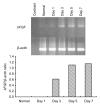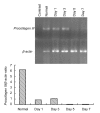Effect of mitomycin on normal dermal fibroblast and HaCat cell: an in vitro study
- PMID: 23225855
- PMCID: PMC3520454
- DOI: 10.1631/jzus.B1200055
Effect of mitomycin on normal dermal fibroblast and HaCat cell: an in vitro study
Abstract
Objective: To evaluate the effects of mitomycin on the growth of human dermal fibroblast and immortalized human keratinocyte line (HaCat cell), particularly the effect of mitomycin on intracellular messenger RNA (mRNA) synthesis of collagen and growth factors of fibroblast.
Methods: The normal dermal fibroblast and HaCat cell were cultured in vitro. Cell cultures were exposed to 0.4 and 0.04 mg/ml of mitomycin solution, and serum-free culture medium was used as control. The cellular morphology change, growth characteristics, cell proliferation, and apoptosis were observed at different intervals. For the fibroblasts, the mRNA expression changes of transforming growth factor (TGF)-β1, basic fibroblast growth factor (bFGF), procollagen I, and III were detected by reverse transcription polymerase chain reaction (RT-PCR).
Results: The cultured normal human skin fibroblast and HaCat cell grew exponentially. A 5-min exposure to mitomycin at either 0.4 or 0.04 mg/ml caused marked dose-dependent cell proliferation inhibition on both fibroblasts and HaCat cells. Cell morphology changed, cell density decreased, and the growth curves were without an exponential phase. The fibroblast proliferated on the 5th day after the 5-min exposure of mitomycin at 0.04 mg/ml. Meanwhile, 5-min application of mitomycin at either 0.04 or 0.4 mg/ml induced fibroblast apoptosis but not necrosis. The apoptosis rate of the fibroblast increased with a higher concentration of mytomycin (p<0.05). A 5-min exposure to mitomycin at 0.4 mg/ml resulted in a marked decrease in the mRNA production of TGF-β1, procollagen I and III, and a marked increase in the mRNA production of bFGF.
Conclusions: Mitomycin can inhibit fibroblast proliferation, induce fibroblast apoptosis, and regulate intracellular protein expression on mRNA levels. In addition, mitomycin can inhibit HaCat cell proliferation, so epithelial cell needs more protecting to avoid mitomycin's side effect when it is applied clinically.
Figures












Similar articles
-
Effects of mitomycin-C on normal dermal fibroblasts.Laryngoscope. 2006 Apr;116(4):514-7. doi: 10.1097/01.MLG.0000205590.62824.0A. Laryngoscope. 2006. PMID: 16585851
-
Keratinocyte growth factor receptor ligands induce transforming growth factor alpha expression and activate the epidermal growth factor receptor signaling pathway in cultured epidermal keratinocytes.Cell Growth Differ. 1994 Dec;5(12):1283-92. Cell Growth Differ. 1994. PMID: 7535082
-
TGF-beta 1 induces proliferation in human renal fibroblasts via induction of basic fibroblast growth factor (FGF-2).Kidney Int. 2001 Feb;59(2):579-92. doi: 10.1046/j.1523-1755.2001.059002579.x. Kidney Int. 2001. PMID: 11168939
-
Induction of PDGF-B in TCA-treated epidermal keratinocytes.Arch Dermatol Res. 2007 Nov;299(9):433-40. doi: 10.1007/s00403-007-0781-6. Epub 2007 Aug 28. Arch Dermatol Res. 2007. PMID: 17724602
-
Upregulation of tumor suppressor protein neurofibromin in normal human wound healing and in vitro evidence for platelet derived growth factor (PDGF) and transforming growth factor-beta1 (TGF-beta1) elicited increase in neurofibromin mRNA steady-state levels in dermal fibroblasts.J Invest Dermatol. 1998 Mar;110(3):232-7. doi: 10.1046/j.1523-1747.1998.00108.x. J Invest Dermatol. 1998. PMID: 9506441 Review.
Cited by
-
Effects of Pirfenidone and Collagen-Polyvinylpyrrolidone on Macroscopic and Microscopic Changes, TGF-β1 Expression, and Collagen Deposition in an Experimental Model of Tracheal Wound Healing.Biomed Res Int. 2017;2017:6471071. doi: 10.1155/2017/6471071. Epub 2017 May 11. Biomed Res Int. 2017. PMID: 28584818 Free PMC article.
-
In Vitro Evaluation of the Healing Potential and Proteomic Study of Quercus robur L. Leaf Extracts in Human Keratinocytes.Molecules. 2025 May 14;30(10):2152. doi: 10.3390/molecules30102152. Molecules. 2025. PMID: 40430324 Free PMC article.
-
Temporins A and B stimulate migration of HaCaT keratinocytes and kill intracellular Staphylococcus aureus.Antimicrob Agents Chemother. 2014 May;58(5):2520-7. doi: 10.1128/AAC.02801-13. Epub 2014 Feb 10. Antimicrob Agents Chemother. 2014. PMID: 24514087 Free PMC article.
-
Evaluation of fibroblasts adhesion and proliferation on alginate-gelatin crosslinked hydrogel.PLoS One. 2014 Sep 30;9(9):e107952. doi: 10.1371/journal.pone.0107952. eCollection 2014. PLoS One. 2014. PMID: 25268892 Free PMC article.
-
Preliminary antifibrotic and vasoconstrictor effects of adrenaline in Schlemm's canal and suprachoroidal minimally invasive glaucoma surgery in primary open-angle glaucoma.Graefes Arch Clin Exp Ophthalmol. 2025 Feb;263(2):489-500. doi: 10.1007/s00417-024-06642-3. Epub 2024 Sep 30. Graefes Arch Clin Exp Ophthalmol. 2025. PMID: 39347799 Free PMC article.
References
-
- Banthia V, Selesnick SH. Mitomycin-C in the Post Surgical Ear Canal. American Academy of Otolaryngology/Head and Neck Surgery Annual Meeting; Orlando, Florida, USA. 2003. pp. 882–886. - PubMed
-
- Battelino S, Hocevar-Boltezar I, Zargi M. Intraoperative use of mitomycin C in fibrous atresia of the external auditory canal. Ear Nose Throat J. 2005;84(12):776–779. - PubMed
-
- Crowston JG, Chang LH, Constable PH, Daniels JT, Akhar AN, Khaw PT. Apoptosis gene expression and death receptor signaling in mitomycin C-treated human Tenon capsule fibroblasts. Invest Ophthalmol Vis Sci. 2002;43(3):692–699. - PubMed
MeSH terms
Substances
LinkOut - more resources
Full Text Sources

